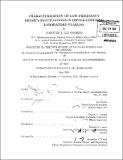| dc.contributor.advisor | Jay IKesner and Darren T. Gariner. | en_US |
| dc.contributor.author | Ellsworth, Jennifer L | en_US |
| dc.contributor.other | Massachusetts Institute of Technology. Dept. of Nuclear Science and Engineering. | en_US |
| dc.date.accessioned | 2011-05-09T15:20:37Z | |
| dc.date.available | 2011-05-09T15:20:37Z | |
| dc.date.copyright | 2010 | en_US |
| dc.date.issued | 2010 | en_US |
| dc.identifier.uri | http://hdl.handle.net/1721.1/62691 | |
| dc.description | Thesis (Ph. D.)--Massachusetts Institute of Technology, Dept. of Nuclear Science and Engineering, 2010. | en_US |
| dc.description | Cataloged from PDF version of thesis. | en_US |
| dc.description | Includes bibliographical references (p. 161-167). | en_US |
| dc.description.abstract | Low-frequency fluctuations of plasma density, floating potential, ion saturation current, visible light intensity, and edge magnetic field are routinely observed in the Levitated Dipole Experiment (LDX). For the purposes of this thesis, we define low-frequency as W << Wbe where Wbe is the electron bounce frequency. These fluctuations in a laboratory dipole confined plasma lead to turbulence mixing that maintain peaked density profiles. The relationship between the different types of low-frequency fluctuations and plasma density transport is considered. Two 16-channel photodiode arrays were designed and constructed to study the spatial and temporal structure of these fluctuations as part of this dissertation. In addition to the photodiode arrays, a four-channel microwave interferometer is used to estimate the density profile and to measure density fluctuations in the plasma. Several electrostatic probes, including a 24-channel floating probe array, measure fluctuations at the plasma edge and eight Mirnov coils measure magnetic fluctuations. The fluctuations fall into three general categories: broadband, turbulent fluctuations observed during nearly all plasma conditions; quasi-coherent fluctuations with low azimuthal mode numbers and peak frequencies on the order 1 kHz observed during discharges with low neutral pressure; and coherent fluctuations with zero toroidal mode number and peak frequencies on the order of 100 Hz, observed during discharges with moderate neutral fueling. The relationship between time-averaged fluctuation characteristics and plasma parameters are explored. The spatial structure of the fluctuations for several representative shots are discussed. The turbulent fluctuations and concurrent density profiles are compared to quasilinear diffusion of interchange mixing in dipolar plasmas for cases where the fluctuations are random. I show that the quasilinear diffusion equation agrees well with the experimental observations of random fluctuations, supporting the conclusion that interchange mixing is causing inward transport that results in peaked density profiles. For other cases, where nonlinear effects appear to dominate the plasma dynamics, the saturated fluctuation amplitudes are compared to the plasma density profiles. | en_US |
| dc.description.statementofresponsibility | by Jennifer L. Ellsworth. | en_US |
| dc.format.extent | 167 p. | en_US |
| dc.language.iso | eng | en_US |
| dc.publisher | Massachusetts Institute of Technology | en_US |
| dc.rights | M.I.T. theses are protected by
copyright. They may be viewed from this source for any purpose, but
reproduction or distribution in any format is prohibited without written
permission. See provided URL for inquiries about permission. | en_US |
| dc.rights.uri | http://dspace.mit.edu/handle/1721.1/7582 | en_US |
| dc.subject | Nuclear Science and Engineering. | en_US |
| dc.title | Characterization of low-frequency density fluctuations in dipole-confined laboratory plasmas | en_US |
| dc.type | Thesis | en_US |
| dc.description.degree | Ph.D. | en_US |
| dc.contributor.department | Massachusetts Institute of Technology. Department of Nuclear Science and Engineering | |
| dc.identifier.oclc | 714407609 | en_US |
